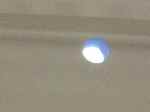Touch 30. 5th & 6th December 2012
I don’t normally go to church…an occasional carol service and, once. the Pearly Kings and Queens Thanksgiving service at St Martin-in-the-Fields. But last week I found myself attending mass at the Church of the Holy Touch. This took place in a large cold room with a single ocular window at the Beaconsfield Arts Centre in Vauxhall, South London. I felt like a spy among the devotees who were attending a two-day celebration of thirty years of Touch.
Jon Wozencroft, the co-founder with Mike Harding, kicked off proceedings with an eloquent exposition of the Touch ethos talking about a triangular relationship between sound, the visual and the social of which this event was an expression. Sadly, the sound element of the next few hours let the equation down as various speakers struggled to be heard over the squeakiest floorboards I have ever experienced, the scraping of chairs and the low noise of trains passing immediately outside. All this felt rather ironic as the subject of much of the conversation was on the technicalities of dealing with recorded sound through mastering, changing formats and multi-channel playback. The more I heard of these discussions the more anxious I became and I wondered if anyone was going to rumble me as an imposter.
How do I listen to music? In the kitchen, through 2 cheap speakers, the sounds of the street creeping in, with a background of cooking noises and with occasional conversation interrupting. On an iPod through in-ear buds – never really isolated from external sound but insulated from it. On a computer through quite small powered speakers. On an evolved (rather than planned) hi-fi with ok components but with speakers positioned too high on top of bookshelves. The room in which this system is installed is the noisiest in the house. The sound from the road outside doesn’t just creep in here it crashes through the ill-fitting windows, a collage of traffic, human voices and sirens. In the car on a clapped-out cassette player. So I never hear recorded sound at home in anything like ‘ideal’ conditions. The formats for all these listening experiences are numerous: MP3 and all its digital cousins, 7” singles and LPs on vinyl, CDs, radio waves, cassettes and even, in extremis, shellac and, once in a blue moon, reel-to-reel tape. It is all whatever I can get my ears on.
As I sat in the big cubic room at Beaconsfield listening to the talks I thought back to the visit I made in the morning to Tate Britain on my way to the Touch event. I went to see and hear the Turner Prize winning installation by Elizabeth Price The Woolworths Choir of 1979.  It fuses sound in the form of a cut-up version of Out in the Streets by the Shangri-Las, finger clicks and hand claps with a series of still and moving images of gothic church architecture, 1960s girl groups and dancers and documentary footage from the fire in a Woolworths’ furniture shop in Manchester. These incongruous elements are edited together into a coherent and moving near-narrative and the sound is loud and immersive. This was the opposite of how I usually hear recorded music and, in its degree of scripting and control, at odds with how I experience most live music too.
It fuses sound in the form of a cut-up version of Out in the Streets by the Shangri-Las, finger clicks and hand claps with a series of still and moving images of gothic church architecture, 1960s girl groups and dancers and documentary footage from the fire in a Woolworths’ furniture shop in Manchester. These incongruous elements are edited together into a coherent and moving near-narrative and the sound is loud and immersive. This was the opposite of how I usually hear recorded music and, in its degree of scripting and control, at odds with how I experience most live music too.
Back at Beaconsfield the Touch events moved into another phase in the evening with performances in a brick-vaulted room situated immediately below the train tracks. This was the payback space for the big white echoing box upstairs where the talks had taken place. The pieces performed here were all punctuated by the sound of the trains passing overhead and this random element gave the performances an open-endedness that I had felt, with a different emphasis, in the Woolworths Choir installation. These moved from beautiful mixes of voice and cello (Hildur Gudnadottir) through a rich and elaborate turntable collage (Philip Jeck), a restrained and poignant audio-visual sequence (David Toop), a four-channel playback of field recordings (Chris Watson) to an immense ‘wall’ of effect and electric guitar (Fennesz).
So here was the culmination of the first day’s proceedings…something for both the faithful and the unbelievers. And on the second day (talks this time with amplification in the upstairs room and yet more enveloping sounds in the railway arch), Wozencroft ended the pilgrimage with a very lo-fi story of broadcasting on pirate radio in the 1980s with his friend Jon Savage and then launched into an improvised acapella version of Blue Monday. I felt this, at least, was in the spirit of my own listening habits.








